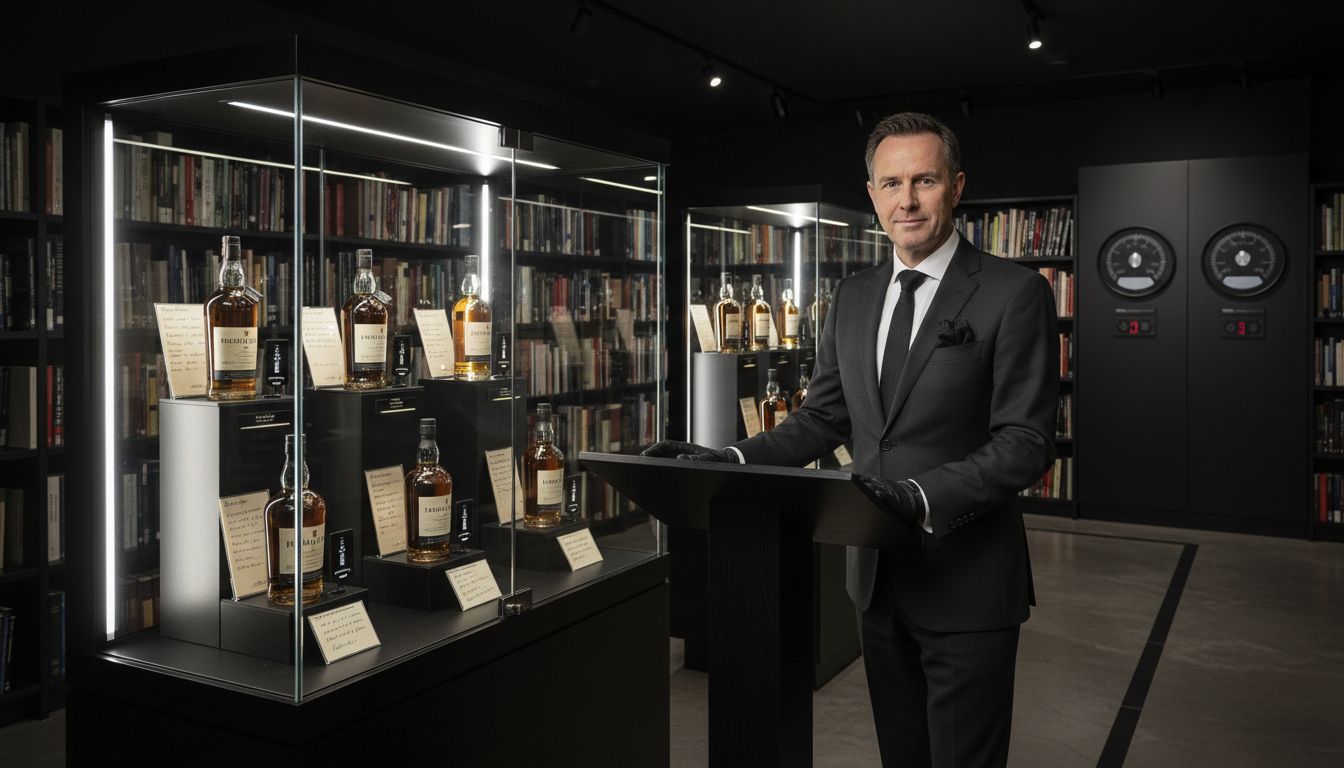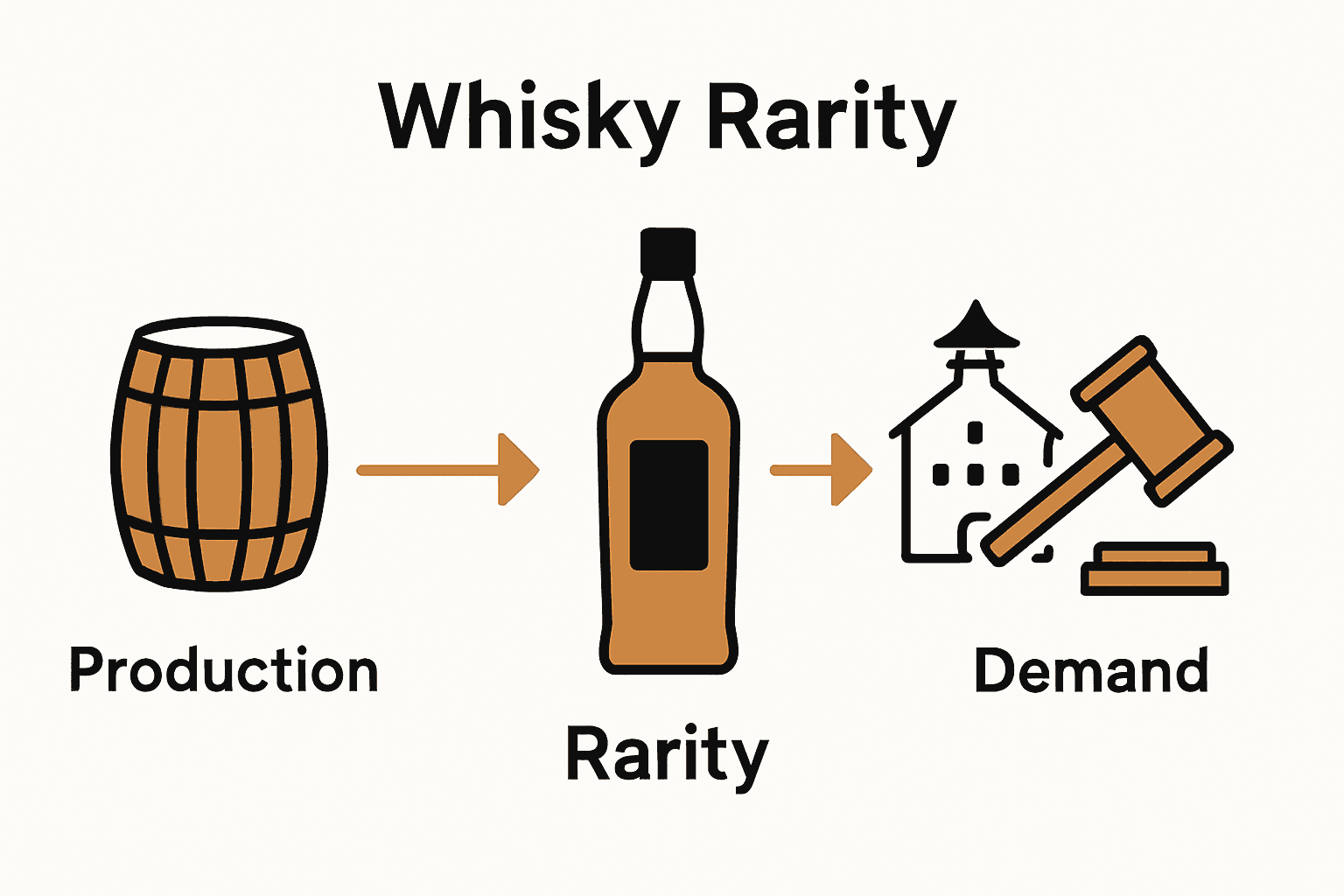Some bottles of whisky fetch prices over USD 1 million at auction, yet rarity goes far beyond a hefty price tag. Understanding what makes a whisky truly rare can change a collector’s entire approach. From production secrets to historic milestones, the concept of rarity blends tradition, innovation, and a touch of mystery. Discover what sets these prized spirits apart and why collectors worldwide treat them as treasures worth chasing.
Table of Contents
- Defining Rarity In The World Of Whisky
- Types Of Rare Whiskies Explained
- Key Factors That Create Whisky Rarity
- How Collector Demand Shapes Rarity
- Investment Value And Authenticity Risks
Key Takeaways
| Point | Details |
|---|---|
| Understanding Rarity | Whisky rarity encompasses factors like limited production, unique aging processes, historical significance, and provenance that make certain bottles highly sought after. |
| Types of Rare Whiskies | Limited Edition Releases, Discontinued Bottlings, and whiskies from closed distilleries represent distinct categories of rarity each with significant collector value. |
| Collector Influence | Collector demand significantly shapes whisky rarity, as enthusiasm for exclusivity and investment potential can dramatically increase a bottle’s perceived value. |
| Investment Concerns | Navigating the rare whisky market involves authentication challenges and value volatility, requiring collectors to exercise due diligence and verification strategies to protect their investments. |
Defining Rarity in the World of Whisky
In the intricate world of spirits, whisky rarity transcends mere scarcity. According to maltbook.com, rarity represents a complex interplay of production nuances, historical context, and collector fascination.
Multiple dimensions contribute to a whisky’s rare status. Key factors include:
- Limited Production Runs: Whiskies produced in minuscule quantities, often fewer than 100 bottles
- Unique Aging Processes: Uncommon maturation techniques or exceptional barrel selections
- Historical Significance: Bottles connected to legendary distilleries or significant whisky-making moments
- Provenance: Exceptional lineage or remarkable preservation conditions
Collectors and enthusiasts recognize that true rarity involves more than simply being hard to find. maltbook.com highlights that exceptional whiskies often possess a compelling narrative beyond their liquid contents. Whether through extraordinary craftsmanship, groundbreaking distillation methods, or remarkable aging environments, these spirits transcend traditional categorization.
Understanding whisky rarity requires appreciating the intricate story behind each bottle. Sometimes a rare whisky emerges from a single unexpected moment of innovation or a distiller’s passionate experiment. For those seeking to explore rare whisky selections, see our guide on rare whisky types every collector should know.
Types of Rare Whiskies Explained
Rare whiskies represent extraordinary expressions of distilling artistry, each with a distinct narrative and exceptional characteristics. maltbook.com provides a comprehensive categorization of these exceptional spirits, highlighting several remarkable types that captivate collectors worldwide.
Limited Edition Releases represent one of the most sought-after categories of rare whiskies. These bottles are characterised by:
- Extremely restricted production numbers
- Unique commemorative packaging
- Special aging or finishing techniques
- Often released to mark significant milestones
Discontinued Bottlings offer another fascinating realm of rarity. When a distillery ceases production of a particular expression, its remaining bottles become increasingly valuable. As maltbook.com notes, legendary examples like the Glenfiddich 1937 Rare Collection demonstrate how historical significance dramatically enhances a whisky’s collectible status.
Distilleries that have closed permanently represent perhaps the most prized category of rare whiskies. Bottles from silent stills - distilleries no longer operational - become instant collectors’ treasures. These whiskies not only represent a finite liquid asset but also encapsulate a moment of Scottish whisky-making history.
 Explore our collection of must-know rare whisky examples to understand the depth of this fascinating world.
Explore our collection of must-know rare whisky examples to understand the depth of this fascinating world.
Key Factors That Create Whisky Rarity
Whisky rarity emerges from a complex constellation of factors that transform an ordinary spirit into a collector’s treasure. maltbook.com reveals the intricate mechanisms that elevate certain whiskies from mere beverages to legendary collectible assets.
Production characteristics play a pivotal role in determining rarity. Key elements include:
- Quantity Limitations: Extremely low production volumes
- Unique Aging Processes: Exceptional barrel selections or experimental maturation techniques
- Distillery Heritage: Bottles from historic or defunct distilleries
- Preservation Conditions: Impeccably maintained storage environments
Distillery Closure represents perhaps the most dramatic catalyst of rarity. As maltbook.com highlights, whiskies from silent stills like Glenury Royal and Port Ellen become instant collectors’ holy grails. These bottles encapsulate not just a liquid, but an entire chapter of whisky-making history that can never be replicated.
The most sought-after rare whiskies often combine multiple rarity factors.
A limited edition from a closed distillery, aged in exceptional casks, and perfectly preserved becomes the ultimate prize for serious collectors. Learn more about identifying rare whisky in our expert guide and unlock the secrets of these liquid treasures.
How Collector Demand Shapes Rarity
The intricate dance between collector enthusiasm and whisky rarity creates a fascinating economic ecosystem that dramatically transforms market dynamics. maltbook.com illuminates how passionate collectors can elevate certain bottles from mere spirits to investment-grade treasures.
Collector Psychology plays a crucial role in driving whisky rarity. Key demand drivers include:
- Exclusivity Factor: Limited production runs that trigger competitive acquisition
- Investment Potential: Bottles viewed as alternative financial assets
- Historical Significance: Whiskies connected to legendary distilleries or remarkable stories
- Aesthetic Appeal: Unique packaging or commemorative designs
Perhaps the most compelling example of demand-driven rarity emerges with Japanese whiskies. As maltbook.com notes, bottles like the Yamazaki 50 Year Old demonstrate how extraordinary collector interest can transform a whisky’s perceived value. What starts as a carefully crafted spirit can rapidly become a sought-after global treasure, with prices escalating exponentially based on collector perception.
The symbiotic relationship between scarcity and desire creates a remarkable phenomenon where collector demand doesn’t just reflect rarity - it actively generates it. Explore our guide on why rare whisky matters to understand this fascinating marketplace where passion meets investment.
Investment Value and Authenticity Risks
Rare whisky investments represent a complex landscape where potential rewards intersect with significant risks. maltbook.com reveals the intricate challenges collectors face when navigating this high-stakes market, particularly surrounding bottle authenticity and valuation.
Authentication Challenges pose significant threats to whisky investors. Critical risks include:
- Counterfeit Bottles: Sophisticated replicas that mimic genuine rare releases
- Provenance Documentation: Complex verification processes
- Storage Condition Impacts: Potential value degradation from improper handling
- Market Volatility: Unpredictable price fluctuations
The investment potential becomes particularly pronounced with extraordinary releases. As maltbook.com highlights, collections like the Macallan 78-Year-Old Red Collection demonstrate how a single bottle can represent extraordinary financial value, but also attract sophisticated counterfeiting attempts. Serious collectors must develop rigorous verification strategies to protect their investments.

Navigating this marketplace requires a blend of passion, expertise, and careful due diligence. Learn more about identifying authentic rare whisky in our expert guide and arm yourself with the knowledge to make informed collecting decisions.
Discover Your Next Rare Whisky Treasure
Understanding what makes a whisky rare can feel overwhelming with so many factors from limited production runs to distillery heritage shaping the value and appeal. If you are eager to explore exclusive whiskies that embody these unique qualities then our curated range of World Whiskies and premium Scotch Whisky (all) - Glenglassaugh collections offers a gateway to those hard-to-find bottles collectors dream of owning.

Don’t wait to unlock the stories behind each rare dram. Visit Uisuki.com.au now for expert guidance, new arrivals, and a carefully chosen selection designed to satisfy your passion for rarity and authenticity. Start your rare whisky journey today and add something truly exceptional to your collection.
Frequently Asked Questions
What factors contribute to whisky rarity?
Whisky rarity arises from several key factors, including limited production runs, unique aging processes, historical significance, and exceptional provenance.
How does collector demand impact the rarity of whisky?
Collector demand can significantly raise the perceived rarity of a whisky. Factors such as exclusivity, investment potential, historical connections, and aesthetic appeal drive collectors to seek specific bottles, enhancing their market value.
What types of whiskies are considered rare?
Rare whiskies include limited edition releases, discontinued bottlings, and whiskies from closed or defunct distilleries. Each of these categories holds unique characteristics that appeal to collectors.
What are the risks involved in investing in rare whisky?
Investing in rare whisky involves risks such as counterfeit bottles, challenges in authenticating provenance, potential value degradation from poor storage, and market volatility influencing pricing.

